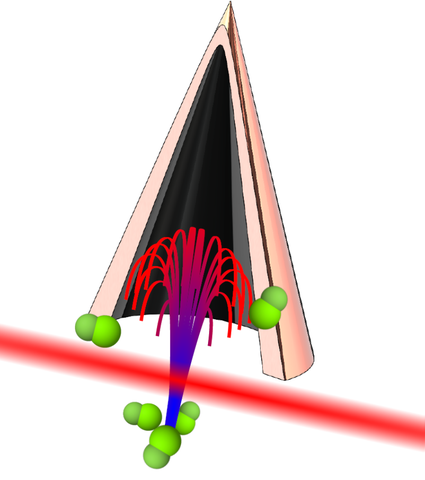Summary
PRIME (Platform for Realizing Integrated Molecule Experiments) aims to establish primary, quantum-based realizations for both the radiometric watt and kelvin for the temperature range 200 K – 600 K. Blackbodies are incoherent electromagnetic radiation sources that are ubiquitous in radiometry and thermometry. By using sensitive, identical quantum systems (such as polar molecules), we will directly measure the blackbody electric field in order to characterize these widely used instruments.
Description

Blackbodies realize a clear relationship between radiated power and temperature through Planck’s law. While a reliable instrument for temperature and power calibrations, blackbodies are afflicted with a plethora of systematics (e.g., non-ideal emissivity, propagation loss, temperature gradients, geometric effects, etc.). And because the sensors they rely on and calibrate are fundamentally classical, they also have long, traceability chains.
Molecules are identical quantum systems whose interactions with electromagnetic radiation have been characterized with exquisite precision and, in many cases, are amenable to ab initio calculation. Blackbody radiation induces transitions between internal quantum states of molecules. By first laser cooling the molecules, then applying laser and microwave fields, molecules are restricted to their two lowest vibrational states, which rapidly thermalize with the surrounding blackbody field. Reading out the population of each state then provides a quantum realization of the Kelvin traceable to the second.
Approach

PRIME builds upon pioneering molecule laser cooling studies using novel techniques to laser cool and trap large samples of molecules. Our approach uses a frequency chirped magneto-optical trap (MOT) that dramatically reduces the experimental complexity by slowing and trapping molecules with a single set of laser beams. Molecule laser cooling techniques can reduce the temperature of trapped molecules to less than 10 microKelvin.
Once the molecules are cooled and trapped, a pushing laser beam launches the ultracold molecules like a fountain into a blackbody cavity placed above the trap. After exiting the cavity, the vibrational state populations are sequentially determined. The properties of the fountain, e.g., its height, angle, and initial position, can be adjusted to vary the trajectory of the molecules to identify thermal gradients in the blackbody. This information is vital for verifying blackbody models and improving future radiometry standards. While a standard cold-atom technique, a laser-cooled fountain would be first-of-its-kind for molecules with broad reaching impacts.
Opportunities
If you are interested in joining our team as a postdoc, guest researcher, collaborator, or student volunteer, send us an email.

